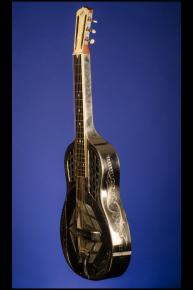An Exceptionally Fine, 1929 German Silver, 'Lily-Of-The-Valley' Hawaiian Tricone Guitar
1929 National Style 3C Hawaiian Triple Resonator 'Lily-of-the-valley'
14 1/4 inch wide, just over 3 1/4 inch deep, arched-back, German Silver "Style 3C Hawaiian" Triple Resonator with 'Lily-of-the-Valley' and 'two-line engraved border' etched onto the body. The sides of the body also engraved with lily-of-the-valley design. The back of the body and the neck also engraved with lily-of-the-valley design. Three resonator cones, with two cones on the bass side and one cone on the treble side. T-shaped bridge cover and handrest. Grid-pattern soundholes on the upper body. Hawaiian style integral square German Silver neck and single-bound ebony fretboard with a nut width of just under two inches, 19 original thin frets (12 clear of body) and inlaid pearl 'fancy square' position markers (the first fret with a triangular pearl inlay). "White Head" mahogany headstock with overlay of cream pearloid with a single engraved thin black border and the National 'shield' emblem engraved in black. Original side-mounted, rear facing, open-back strip tuners with oval cream bone buttons. Serial number "1436" stamped onto the back of the neck, just below the headstock. At the body end of the neck "PAT PEND" is stamped into the top of the body. Wooden bridge and specific National nickel plated tailpiece. There are just two tiny indentations in the German Silver body, one on the bass-side of the back and the other on the bass-side of the German Silver neck, just by the eighth fret. The three cones have been expertly replaced by George Gruhn and this amazing piece of musical history sounds incredible. This is the finest example, by far that we have ever seen. We conservatively give it an exceptionally fine (9.00) rating - had it not been for the expert re-cone we would have given it a strong (9.25+).Housed in the original five-latch, shaped, black hardshell case with purple plush lining (8.50).
Style 3 applies to Hawaiian and Spanish tricone guitars, tricone and single-cone tenor and plectrum guitars, mandolins, and both large & small ukes. This beautiful style was the top-of-the-line model for all the above instruments except tricone guitars and Hawaiian guitars (see styel 4). The engraving detail is exquisite, and the lily-of-the-valley motif was designed by John Dopyera and his wife. Made from 1928-1941, five variations were produced. While the actual pattern of the engraving was consistent, the positioning of the fronds of lilies was changed on the guitar top as follows:
A: 3 separate fronds on coverplate c.#400-500
B. no lilies on coverplate, fronds descending
C. no lilies on coverplate, fronds ascending
D. 3 half-fronds on cover attach to rest of top engraving
E. whole pattern floes over top, thru cover, 1933-41 (after serial #c.2500, only seen on Hawaiian models)
National Squareneck (Hawaiian) tricones, besides a few non-serialized prototypes with pre-standard logo, begin at serial number 100, in June-July 1927. This series continues to at least # 3233, when in 1934-1935 the last few California squareneck tricones were numbered in with the S-series style O guitars. After 1935, tricones were given regular Chicago series numbers, with A, B, C, L or G prefixes.
Tricones under c.400 exhibit one or more early features. Only the first forty tricones have the seven extra holes cut in the top outside the perimeter of the coverplate, though about another fifty retain the "woven" upper grilles. The first forty instruments are stamped "PAT APPL'D FOR". After that, they are stamped "PAT PEND" until c. #1890 when patents were granted (June 1930) and the stampings reflected this. The metal well replaced the wooden well after about 250-280 instruments (c. #380). Arched backs replaced flat backs around the same time. Studded tailpieces were probably purchased by National in a lot of 500, before the company began making their own non-studded tailpieces. Somewhere between #500 and #600, the tailpieces were changed over.
Totaling these instruments, plus another 100 or so S- prefix tricones, yields a figure of about 3,500 squareneck tricones made from 1927 to 1935. Considering the fact that resonator instruments (particularly expensive ones) became a smaller and smaller part of National's business during the Chicago-era, an estimate of a further 2,000 squareneck tricones seems very liberal. This figure will always be an estimate, since all Chicago instruments were numbered together.











